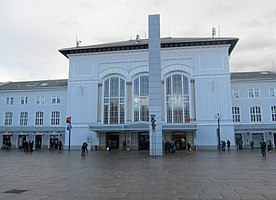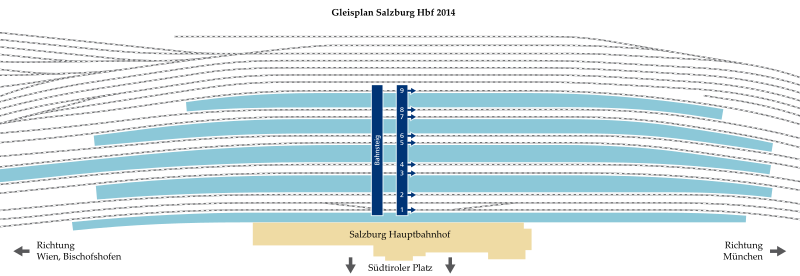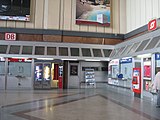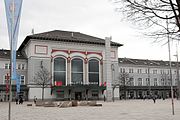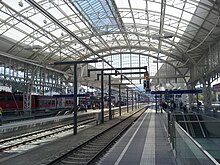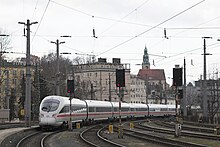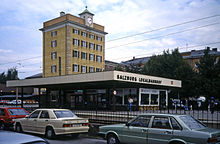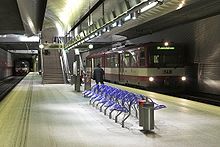Salzburg main station
| Salzburg main station | |
|---|---|
|
View from Südtiroler Platz
|
|
| Data | |
| Design | Through station |
| Platform tracks | 9 through tracks 2 local train station |
| abbreviation | Sb (ÖBB), XASB (DB) |
| IBNR | 8100002 |
| opening | 1860 |
| Architectural data | |
| architect | Rudolf Bayer (1860), Kada Wittfeld (2014) |
| location | |
| City / municipality | Salzburg |
| state | Salzburg |
| Country | Austria |
| Coordinates | 47 ° 48 '47 " N , 13 ° 2' 45" E |
| Height ( SO ) | 423 m |
| Railway lines | |
|
|
| List of train stations in Austria | |
The Salzburg main train station is the most important train station in the Salzburg metropolitan area and an important traffic junction in western Austria . It is frequented by around 25,000 travelers every day and for a long time served as a border station towards Germany .
The Salzburg main station is a station of both the Austrian Federal Railways (ÖBB) and the Deutsche Bahn AG (DB). Several ÖBB long-distance and local routes are linked in it. These are the Westbahn from Vienna and Linz and the Rosenheim – Salzburg railway line , which not only provides international trains but also corridor traffic via Rosenheim (the Deutsche Eck ) with fast connections to Tyrol and Vorarlberg. Another main route to the south is the Salzburg-Tyrolean Railway via Bischofshofen and Zell am See to Wörgl main station , from which in Schwarzach-St. Veit the Tauernbahn branches off. The main station also has a loading point for motorail trains .
In regional traffic, the main train station is the starting point for the railway line to Lamprechtshausen and Ostermiething as well as a junction between the Salzburg S-Bahn and several regional bus routes in the greater area. One of the central nodes in the route network of the Salzburg trolleybus and the city bus routes is also located here . By 1957 , the narrow-gauge Salzkammergut local railway to Mondsee and Bad Ischl began at the old local train station on the station forecourt, Südtiroler Platz .
The station (reception building, central platform) is a listed building and is located in the buffer zone of the UNESCO World Heritage Historic Center of the City of Salzburg . It underwent a complete renovation between 2009 and 2014, and the work was completed with the opening ceremony on November 7, 2014.
Location and building design

Salzburg's main train station is in Elisabeth-Vorstadt , the old town is delimited by the Neustadt district .
The reception building of the train station is on Südtiroler Platz with the bus station for regional buses and the bus stop for the city bus routes. There are also cafes, restaurants and a shopping center around the square.
To the south, the passenger station extends to Saint-Julien-Strasse or Gabelsbergerstrasse ; the continuous street crosses under the tracks running out of the station towards Germany in the Nelböck viaduct . To the east of the freight tracks is the freight road , to the west the Rainerstraße , the Südtiroler Platz and the Engelbert-Weiß-Weg border the railway facilities. To the north, the tracks merge to form the Westbahn in the direction of Vienna and the Salzburg-Tiroler Bahn in the direction of Bischofshofen.
The station area falls into three districts , Elisabeth-Vorstadt in front of the station, Itzling in the north, and Schallmoos on the freight station side, and in two cadastral communities , mostly Salzburg and at the north end of Itzling .
The reception building itself and the historic platforms are still part of the buffer zone of the UNESCO World Heritage Historic Center of the City of Salzburg , so they are not directly under UNESCO protection, but the core zone should be protected from disturbances in the soft surface. In the buffer zone, too, the more dominant buildings require the approval of the UNESCO commission, even if the building is low, as the city can be seen so well from above from the city mountains. The reception building and central platform are also under monument protection .
Reception building
The station buildings on the Westbahn were all replaced - often several times - by newer ones. Only the Salzburg station building was largely preserved in its original form. The building, decorated with ornaments, is now a listed building .
After the opening of operations, the station building consisted of a central wing and, on both sides, a wing structure that was offset to the rear, to which in turn a slightly forward wing was attached. The service rooms, waiting rooms and check-in counters were in the left part of the building. With the renovation of the station from 1906 to 1909, the reception building was also renovated and redesigned. A particular stroke of luck was the recovery of the original tile design of the waiting hall, which had been hidden behind wall panels for decades and was preserved in the best possible condition.
Since then, the building elements have not been changed any more. The building now has a gable roof and is painted white and gray. The middle wing is decorated with red style elements.
In the course of the station renovation, the reception building was also modernized; UNESCO, the Federal Monuments Office, the City of Salzburg and the ÖBB agreed that the facade must be retained in its existing form.
In 2014, a comparatively spacious access structure was erected on the back of the train station on Load Street.
Central platform
The central platform , a central and spacious island platform , was built between 1906 and 1909 when the station was renovated. Construction began on February 19, 1906, and was opened on July 5, 1909. In the course of the renovation, the island platform was closed in 2009, then dismantled and replaced by conventional central platforms.
The central platform measured 164.5 meters by 52 meters, which corresponds to an area of 8554 square meters. The central platform had a listed roofing, which is now integrated into the newly built facility. On the central platform there was a traffic pavilion with, among other things, catering facilities. On both sides of the narrow side of the central barrier, several head tracks ended, on the west side coming from Germany, on the east side trains from Austrian directions ended here. Until the end of 1997, access to the trains to Germany was via a border control, which was housed in another building on the island platform. There were through tracks on the long sides of the central barrier. At its eastern end, at the level of the head tracks, there were two staircases to a pedestrian bridge over the road to the road ( Schallmoos district ), which previously could only be reached from outside the station building for a long time.
Platform tracks
Until the renovation work began, the station had 14 platform tracks. Track 1 was on the house platform, followed by a through track and then track 2 on the central platform. In the west of the central barrier in the direction of Vienna were tracks 11-15, on the east side in the direction of Germany there were tracks 21-24. Track 3 connected to the south of the central platform. This was followed by another central platform on which tracks 4 and 5 were located.
The renovation of the station brought with it a reorganization of all facilities; 9 continuous platforms were built by October 2013. House platform 1, the through track and the new middle platform 2/3 have been in operation again since November 2011. In the meantime, platform 3 to 33, platform 4 to 34 and platform 5 to 35 have been renamed because otherwise there would have been overlaps in individual construction phases, for example because there would have been an old and new platform 4 at the same time. Platforms 4 and 5 have been in operation in their new location since June 2012, with track 5 being split in two so that platform 14 can be reached via a wooden walkway. This was the last platform of the old station before it was demolished in June 2013. Platform 6/7 was opened in August 2013, platform 8/9 went into operation on September 20, 2013.
The old pedestrian crossing from platform 4/5 over the tracks to Cargo Street was removed in spring 2013. Since then, the passage between the station forecourt and Schallmoos has been provisionally in operation. On November 7, 2014, it was finally opened together with the spacious train station entrance on the Schallmooser side.
history
planning
The first plans to build a railway line from Salzburg to Vienna were made between 1838 and 1842. In June 1851, a state treaty between Bavaria and Austria was signed, in which the construction of a railway connection from Munich to Salzburg and from Salzburg to Vienna was resolved. The station should serve as a community station and be planned together. In the State Treaty it was stipulated that in future decisions affecting the train station would be made jointly. A usage regulation was also laid down therein. The use of the tracks in the train station and up to the train station was on the one hand only allowed for the Royal Bavarian State Railways , on the other hand only Austrian railways. Another part of the station area was intended for common use. Since the opening date agreed in the State Treaty could not be kept due to difficult terrain work during the construction of the railway line in Austria, a new contract was signed on April 21, 1856. This obliged Austria to complete the railway line to Vienna in the following five years.
For the location of the train station, the decision was initially made to go to the left bank of the Salzach. The Salzburg municipal council, however, was not satisfied with this solution and in 1853 planned the construction of a train station on the right bank of the Salzach in the then - now incorporated - suburb of Froschheim . The advantages of this location were touted as the direct connection to the Salzburg city center and the greater proximity to the Salzach, since it was expected that this would allow freight to be reloaded more efficiently onto ships.
After negotiations with the military, police, state government, municipal government and representatives of the city ministry, an agreement was reached on June 21, 1856 on a location for the train station on the right of the Salzach near the northern ramparts. The construction to the left of the Salzach would have been cheaper and topographically easier, but there was fear that a second city center could emerge. The reason for this is assumed that the city administration pursued an interest in selling expensive old town properties.
In view of the cost situation, the Kaiserin-Elisabeth-Westbahn-Gesellschaft and the Bavarian state continued to advocate building the station to the left of the Salzach, but the Austrian Ministry of Commerce also decided on the current location on April 18, 1859. The Kaiserin-Elisabeth-Westbahn-Gesellschaft was convinced of the advantages in the same year, the State of Bavaria only the following year.
Operation after the opening
The train station was officially opened on August 12, 1860, with the opening of the Bavarian Maximiliansbahn from Munich via Rosenheim to Salzburg and within Austria-Hungary with the Kaiserin-Elisabeth-Bahn to Vienna (which corresponds to today's Western Railway ) to the international railway network tied up. At that time the station was laid out as a through station, at that time it had a reception building and two platform tracks, as well as some facilities for operation and freight traffic. The operating facilities consisted of a workshop and a boiler house for Bavarian trains, a car depot, which was also provided for the Bavarian trains, a boiler house and a workshop for the Austrian Railways. In addition, operating facilities such as water towers were to be used jointly. The freight facilities consisted of an Austrian and a Bavarian freight shed as well as Austrian and Bavarian loading ramps.
In 1873 Bahnhofstrasse, which led from the city center into the forecourt, was renamed Westbahnstrasse . In 1886, the Salzburg Railway and Tramway Company (SETG) built its own local train station on the forecourt. This is where the Salzburg tram lines started.
In the following years it soon became apparent that the station would no longer be able to cope with new line accesses. The Tauern Railway , for example, was in the planning stage, which led to the expectation of an increase in traffic for the Salzburg train station as well, so that its expansion was deemed necessary. The Austrian Railways decided, together with the Royal Bavarian State Railways, to renovate the station with a separation of freight and passenger traffic.
Freight traffic should be relocated to Salzburg-Gnigl, the current location of the marshalling yard. A mixture of a terminus and a through station was planned for passenger traffic. Initially, two through tracks were planned next to the receiving station, where important international trains such as the Orient Express were to stop. The central platform was designed for the Bavarian and Austrian regional trains , with five head tracks ending on both sides. Further through tracks were also planned. In addition, the station footbridge, a pedestrian crossing over the tracks, was to be relocated from its original position, as the intention was to build a post office on its old starting point.
The Bavarian depot was relocated to Freilassing , which is why only a six-hour locomotive shed was planned in Salzburg. In the north of the railway facilities, a roundhouse was intended for the Austrian railways.
Reconstruction of the station around 1900
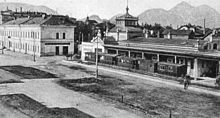
In 1889 the first plans were made public. A new post office was opened in 1902, and the footbridge on the north side was rebuilt at the same time. In 1902, the construction of the new marshalling yard in Salzburg- Gnigl began; it was put into operation on January 3, 1905. Work on the substructure of the actual station took place from February 4, 1904 to June 1906. Construction on the central platform began on February 19, 1907.
In 1909 the station, which was partially redesigned as an island station, was opened. Parallel to the station building, which is located on a through track, another building was erected on a wide platform, the central platform. A round roof structure arched over everything, giving the impression of a hall. There were through tracks on the long side of this hall, and head tracks were laid on the two narrow sides: on the northeast side for inner-Austrian traffic and on the southwest side for trains to and from Bavaria. During the renovation, the Austrian office was separated from the Bavarian one; this got a separate area with its own dispatcher. In addition, the side of the station that was intended for Bavaria was now separated by a customs post.
With the expansion of further routes, most recently with the completion of the Tauern Railway to Villach and on to Trieste in 1909, the importance of Salzburg Central Station as a traffic junction increased. From 1886 the Salzburg Local Railway and from 1893 the Salzkammergut Local Railway departed from the local train station that was built on the station forecourt and no longer exists today.
During and after the Second World War
In 1944 and 1945, the station and the tracks were the target of numerous bomb attacks by American naval units during World War II. The station was partially destroyed as a result.
Some duds are still suspected today in the area of the railway systems in the ground, which repeatedly leads to problems during civil engineering work. In July 2003, the unsuccessful defusing of a 250 kg air bomb cost two explosives experts their lives. In July and August 2007, the ÖBB searched the area of the station for further hidden bombs. During the renovation work on the station, bomb probes are repeatedly carried out to ensure safe work.
Redevelopment of the forecourt in the 1980s / 1990s
In 1988 the forecourt was redesigned, a new department store with a hotel (old forum ) was built, the post tower was demolished, the station post office was rebuilt and an underground car park was built. It was a design by the German architect Joachim Schürmann , the winning project in the 1986 international architectural competition.
Since 1996 the local railway Salzburg – Lamprechtshausen has had its starting point in a station under the Südtiroler Platz. An underground extension of the railway as a subway or light rail in or through the city center was planned and will continue to be traded as an option. With the construction and expansion of the S-Bahn system in the greater Salzburg area , the significance of the station is being upgraded again, although it was increasingly reaching its capacity limits due to the few through tracks before the current renovation.
The original design by Schürmann was only partially implemented. Relocating the bus terminal underground was a central concern in order to obtain a completely traffic-free, park-like forecourt, which should have been an attractive “gateway” to the tourist city of Salzburg. At the same time, the Bahnhofsviertel would have been made more attractive as a residential area. These plans were not implemented for financial reasons; At today's forecourt, foot traffic for travelers and residents, bicycle traffic and public transport of trolleybuses, city buses and regional buses intersect with private transport. The traffic-free area and the park, right next to the street that crosses the square, only take up part of the Südtiroler Platz, the terminal suffers from a lack of space. In terms of urban planning, the project - in the current state of construction - is largely a failure, only the connection of the local railway to the Westbahn meets modern standards.
The labyrinth fountain was set up on the direct station forecourt, a memorial for the victims of National Socialism by Heimo Zobernig (2002) in the park , and a beech grove was also planted.
Remodeling in the 2000s / 2010s
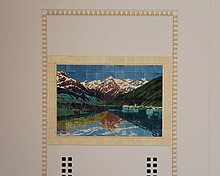
The structure of the station with its head platforms and five continuous platforms was considered to be more of a hindrance than sensible for rail traffic in view of the open national borders after joining the Schengen area . Therefore, as part of the so-called ÖBB train station offensive , it was decided to completely rebuild the tracks and platforms, with the head platforms being replaced by continuous platforms and the three underground track accesses by a wide shopping arcade under all the tracks from Südtiroler Platz to the rear of the station on the southern freight road Side of the tracks were replaced.
The architectural competition was won by Klaus Kada from Kadawittfeldarchitektur , who had already designed the new main train station in Klagenfurt . His winning project was presented in May 1999. This construction measure, which was necessary for the functionality as a clock hub in long-distance and local traffic, was delayed again and again, among other things because of a controversy about the marble hall, which was located in the building on the wide island platform ( central platform ) and had to be removed for the renovation. The marble hall was a hall of the late secessionist train station restaurant that was built after the Second World War . A citizens' initiative postulated that it was historically valuable and should therefore be preserved. As a compromise, the city of Salzburg suggested demolishing the hall and rebuilding it in another location in the new building. The competent authority later ended the dispute by approving the demolition under these conditions. The marble from the marble hall was professionally removed under the supervision of the monument protection office and is stored by the ÖBB - for possible later use. In July 2016, the Augustiner Bräu Kloster Mülln bought the parts of the marble hall. In April 2017, the rebuilt hall was finally opened in the Bräustübl. By removing panels in the entrance hall of the station, well-preserved tile pictures from the 1910s have come to light again.
The steel roof structure of the two main halls on the island platform was previously a listed building . That is why it was carefully removed at the beginning of November 2009, dismantled into over 2,000 individual parts, in order to be restored in a Zeman factory in Poland and integrated into the new train station. In February 2011 the first of the seven arches of the construction was erected again and installed under a newly erected glass roof.
The total budget for the new station was 270 million euros, of which just over 10% was contributed by the State of Salzburg. The groundbreaking took place on November 7th, 2008. According to the ÖBB project manager, the work was exactly on schedule. The station should be completed in 2014 and was actually officially opened on November 7, 2014.
The renovation with ongoing operation required special measures from the planners:
- From 2009 to June 2012, the ÖBB service facilities were moved to containers on the station forecourt. There was the counter hall, ticket machines, travel center, train station restaurant, book, magazine and tobacco shop as well as an info box including an exhibition on the station renovation. In June 2012 the tobacconists, ÖBB info center and ticket sales and Press & More moved to the new tunnel passage, the container is now only used by the café and a bakery branch.
- The reduced number of available tracks posed a logistical challenge in the high phase of the renovation for maintaining operations according to the timetable. As a result, there were repeated changes to the railroad track used and, in individual cases, delays in train traffic.
- As of October 27, 2009 the station forecourt was only available to a limited extent for individual traffic, public transport was not affected.
- Until November 2011, access to the platforms was temporarily regulated differently; the old ticket hall, which no longer fulfills this function, was closed and temporary entrances to the trains were to the left and right of the station building. From November 2011 to June 2012, tracks 33–35 (formerly 3–5) were served via a temporary wooden ramp. All platforms were dismantled and reopened on September 20, 2013; access is via the central passage.
The Salzburg main train station was named the second most beautiful train station in Austria in the VCÖ train test in 2003 . Due to the restrictions due to the construction site, the assessment naturally deteriorated. In 2010 and 2011, the station was found to be the ugliest station in Austria. After the partial completion of the station, its reputation improved and in 2012 it was listed in 5th place, 3rd in 2013 and 1st in 2016 of the most beautiful train stations in Austria.
traffic
Long-distance transport
Since its opening, Salzburg's main train station has been a hub in long-distance traffic that was served by well-known trains such as the Orient Express , the Transalpin or the Tauern Express .
Railjet Express (RJX) trains on the Munich - Budapest route currently stop here every two hours . The station is served by the Eurocity lines EC 62 and EC 32, which together have a two-hour cycle. One pair of trains runs on the EC 62 line from Munich to Klagenfurt , two pairs of trains go from Frankfurt am Main to Klagenfurt, another from Frankfurt to Graz , one from Frankfurt to Vienna and a pair of trains from Saarbrücken to Graz. One pair of the EC 32 trains runs from Münster or Dortmund to Klagenfurt and is called Wörthersee . With individual train pairs, the IC line 60 Karlsruhe – Munich – Salzburg and the Railjet line Salzburg – Vienna also end at Salzburg main station. In addition, the Vienna – Bregenz / Zurich RJ line runs every hour . Since December 2011, WESTbahn trains have also been running to Vienna every hour .
Since December 13, 2015, the Railjet trains have been traveling to Vienna Airport via Vienna Central Station, but they no longer go to the Westbahnhof . This means that it is no longer necessary to change trains in Vienna to the U-Bahn and S-Bahn. The travel time is now 2:49.
With the 2016/2017 timetable change , the night train connections from Salzburg were expanded. These are operated by the ÖBB under the new name NightJet . The timetable includes connections to Zurich HB , Venezia Santa Lucia , Bregenz , Vienna Hbf , Budapest-Keleti , Roma Termini , Munich Hbf , Milano Centrale , Zagreb Glavni Kolod. , Rijeka .
| line | route | Clock frequency |
|---|---|---|
| Western Railway | Salzburg Hbf - Attnang-Puchheim - Wels - Linz - Amstetten - St. Pölten - Vienna Hütteldorf - Vienna West | Hourly |
| RJX | Vienna Airport - Vienna Central Station - Linz - St. Pölten - Salzburg - Wörgl - Innsbruck - Bregenz / Zurich | Hourly |
| RJ | (Klagenfurt -) Salzburg - Linz - Vienna - Vienna Airport | Hourly |
| RJ 90 | Munich - Rosenheim - Salzburg - Linz - Vienna - Budapest | 2 hourly |
| EC / IC 62 | ( Frankfurt - Heidelberg / Saarbrücken - Mannheim -) Stuttgart - Augsburg - Munich - Salzburg (- Klagenfurt / Graz ) | 2 hourly |
| IC 60 | Karlsruhe - Stuttgart - Augsburg - Munich - Rosenheim - Salzburg | individual trains |
| EC 32 |
Wörthersee: ( Münster -) Dortmund - Essen - Duisburg - Düsseldorf - Cologne - Koblenz - Mainz - Mannheim - Heidelberg - Stuttgart - Augsburg - Munich - Salzburg - Klagenfurt |
a pair of trains |
| RJ (X) | Wörgl - Kitzbühel - St. Johann - Saalfelden - Bischofshofen - Hallein - Salzburg - Wels - Linz - Amstetten - St. Pölten - Vienna (- Vienna Airport) | seasonal trains on weekends |
| NJ |
ÖBB Nightjet : Munich - Salzburg - Firenze - Roma |
a pair of trains daily |
| NJ |
ÖBB Nightjet: Munich - Salzburg - Villach - Verona - Milan |
a pair of trains daily |
| NJ |
ÖBB Nightjet: Munich - Salzburg - Treviso - Venice |
a pair of trains daily |
| NJ |
ÖBB Nightjet: Bregenz - Feldkirch - Salzburg - Wels - Linz - Vienna - Vienna car train system |
a pair of trains daily |
| EN |
EuroNight of the Hungarian Railway MÁV: Budapest-Keleti - Győr - Vienna - Linz - Salzburg - Innsbruck - Feldkirch - Buchs - Zurich |
a pair of trains daily |
| EN |
Czech Railways ČD EuroNight: Praha - Freistadt - Linz - Salzburg - Innsbruck - Feldkirch - Buchs - Zurich |
a pair of trains daily |
| ASN |
Alpen-Sylt night express: Salzburg - Munich - Augsburg - Nuremberg - Würzburg - Frankfurt am Main - Hamburg - Husum - Sylt |
two pairs of trains a week |
Regional traffic
From Salzburg main station there are direct connections in the direction of Munich , Landshut , Mühldorf am Inn , Linz , Wörgl and Braunau . The regional trains usually end at Salzburg Central Station.
| Train type | route | Clock frequency |
|---|---|---|
| M. | Munich - Rosenheim - Traunstein - Freilassing - Salzburg | Hourly |
| REX | Braunau am Inn - Salzburg - Freilassing | Hourly |
| REX | Salzburg - Bischofshofen - Saalfelden - Wörgl | 2 hourly |
| R. | (Freilassing) - Salzburg - Straßwalchen | Hourly |
| RB | Salzburg - Freilassing - Mühldorf (- Landshut ) | Hourly |
S-Bahn traffic
The Salzburg main station is served by four S-Bahn lines of the S-Bahn Salzburg , at the same time it serves as a central transfer point between the lines. The S-Bahn lines S1 and S11 leave from tracks 11 and 12 in the basement of the local train station.
| line | Line course | Clock frequency |
|---|---|---|
|
|
Salzburg (basement) - Bürmoos - Lamprechtshausen | Half-hourly |
|
|
Local Railway Express (LEX)
Salzburg (basement) - Bürmoos - Trimmelkam - Ostermiething |
single pairs of trains |
|
|
Freilassing - Salzburg - Straßwalchen (further as R) - Wels - Linz | Hourly |
|
|
Bad Reichenhall - Freilassing - Salzburg - Golling-Abtenau (every hour to Schwarzach Sankt Veit, every two hours to Saalfelden) | Half-hourly |
|
|
Berchtesgaden - Bad Reichenhall - Freilassing - Salzburg | individual trains |
Connection to local public transport
In front of the station building there is a bus station on Südtiroler Platz . From there, a number of regional buses run to the area around Salzburg. In addition, the main train station bus stop is a central transfer point for the Salzburg trolleybus and the city buses operated by Albus .
The Salzburger Lokalbahnhof is located on two floors under the station forecourt, where the route of the Salzburg Local Railway (S 1 and S 11) begins. The distribution level on the first underground floor is designed in such a way that one exit leads to the platform for all buses in the direction of the city center and a second stairway leads to the buses in the direction out of town. A third entrance is to the former counter hall of the reception building.
On the Schallmooser side of the station there is a bus stop for the city bus line 22 as well as for international buses next to the entrance.
Connection to long-distance bus services
The long-distance bus station Salzburg-Ladenstraße is located in the Linienstrasse, accessible via the northern entrance and exit of the main train station, which is served by national and international long-distance buses from Flixbus , Eurolines and globtour .
Salzburg local train station
In 1886 a separate train station was built on the station forecourt for the Salzburg – Hangender Stein local train (from 1886) and the Salzburg tram (from 1887). From 1891 the narrow-gauge trains of the Salzkammergut local railway , which also ran as a local railway from Salzburg to Mondsee or Bad Ischl , also stopped at the local train station. In 1896 the Salzburg – Lamprechtshausen local railway was also integrated into the local train station, which also began in a new north train station of the local train station. In 1909, at the same time as the station was renovated, the local station was also rebuilt, in 1926 the station forecourt was renamed, in memory of the loss of South Tyrol, it was called Südtiroler Platz - like many other station forecourts in Austria . Also because a number of emigrants from South Tyrol ( option ) arrived at the train stations or were stranded.
In 1940 the trolleybus replaced the tram. In 1953 the local railway to the south of the city was shut down. On September 30, 1957, the Salzkammergut Railway to Bad Ischl ended, only the route to Lamprechtshausen has been preserved to this day. The line closures made the local station unnecessary; the northern part was demolished in 1973, the southern part in 1978. A small stop building and a central platform were sufficient for local railway operations.
From 1992 to 1996, the local train station was rebuilt in a lower location according to the plans of Joachim Schürmann in order to be able to expand and redesign the station forecourt. Since 2011 there has also been access to the local train station through the restored train station hall. The two tracks of the local station were given the numbers 11 and 12 after the station renovation.
Freight station Salzburg

The freight station is the "back" of the main station, on the Schallmooser side, a little north (towards Vienna) of the main building. As early as the 1860s, extensive goods handling infrastructure was built here, and so the station also became the urban development core of the “Schallmoos” moorland area, which was undeveloped until the 19th century. This is why the Linienstrasse got its name (the train station also has the addresseselo street). The freight stations of the former Salzkammergut local railway and today's local railway towards Lamprechtshausen were connected to it (freight station Itzling) .
During the First World War, an Austro-Hungarian mining site was set up here for enemy booty. Since that time, the loading station of today's Rolling Landstrasse (RoLa / ÖKOMBI on the part of Rail Cargo Austria ) of the Salzburg-Tiroler-Bahn - Tauernbahn through the Tauern tunnel (Tauernschleuse) towards Italy, Southeast Europe and Asia, to the Triest-Fernetti station has been at the freight station .
The loading is characterized by its good motorway connection (around 2 km with almost no intersections to the Salzburg-Nord junction of the West A1 motorway, Exit 288). The smuggling takes place within the framework of the weekend driving ban for trucks in 24-hour operation outside of the weekend, with extensive waiting and parking facilities. Loading for cars is also possible directly in Böckstein in the Gastein Valley.
The freight customs office for north-west as well as south and south-east Europe was also located here.
As part of the last station renovation, the customs office (Zollamt Salzburg Zollstelle Liefering / Bahn) and increasingly also the Rollende Landstrasse were relocated to the Salzburg container terminal in Siezenheim-Liefering, which is even more convenient in terms of transport.
See also
literature
- Armin Franzke, Josef Mauerer: 1860–2010: 150 years of the Rosenheim - Salzburg line. PB Service, Munich 2010, ISBN 978-3-9812639-2-3 .
- Ronald Gobiet among others: The new Salzburg main train station: Stations in its history from 1860 to 2014. (= Salzburg contributions to art and monument preservation. Volume VI). 2012, ISBN 978-3-7025-0665-0 .
Web links
To convert:
- Information from ÖBB Infrastructure on the renovation of the station ( memento from January 17, 2014 in the Internet Archive )
- Reconstruction of Salzburg main station , www.kadawittfeldarchitektur.de
- Jana Breuste: A brief guide to demolishing a monument. The Salzburg main train station. (PDF) In: kunsttexte.de. February 2013, accessed January 23, 2017 .
- Reinhard Kriechbaum: Goodbye, central platform! In: DrehPunktKultur. June 27, 2012, accessed May 22, 2015 .
- Norbert Mayr: How the wrecking ball came about. In: DrehPunktKultur. June 28, 2012, accessed May 22, 2015 .
- Norbert Mayr: What is still there and what is missing. In: DrehPunktKultur. June 28, 2012, accessed May 22, 2015 .
- Monument of the month September 2011. Everything on rails: Salzburg's main train station - a modern transport hub with historic architecture. Federal Monuments Office , accessed on May 22, 2015 .
- Salzburg main station . In: Salzburger Nachrichten : Salzburgwiki .
Individual evidence
- ↑ Kubinsky, pp. 38/39.
- ↑ Salzburg Central Station: End of the detours. In: The press. July 6, 2011, accessed January 31, 2013 .
- ↑ Terminal description ÖBB Autoisezug car loading point Salzburg Hauptbahnhof (PDF file)
- ↑ UNESCO took note of the building plans while preserving the historical building fabric. She judged the inadequate cooperation in the multi-storey redevelopment of the square of the old station post office , which is just outside the buffer zone, somewhat more critically (“ It is regrettable that that no further information was submitted by the Austrian authorities on the consultation process for this project, nor concerning potential visual impacts on the visual integrity of the property. ”) State of Conservation (SOC): Historic Center of the City of Salzburg (2008) Report, section Current conservation issues: Buffer zone and Beyond the buffer zone . The construction work itself was approved in 2005. State of Conservation (SOC): Historic Center of the City of Salzburg (2005) , section Current conservation issues: Buffer Zone and beyond .
- ^ Railway yearbook. 1st year, p. 121.
- ^ History of the Maximiliansbahn ( Memento from May 14, 2010 in the Internet Archive )
- ↑ Christiane Krejs: Salzburg's city expansion in the 19th century. Dissertation . Salzburg 1990, pp. 105-108 Cf. TN: A contribution to the Salzburg train station question. In: NSZ No. 109, May 17, 1853.
- ↑ a b c d Armin Franzke, Josef Mauerer: 1860-2010: 150 years of the Rosenheim - Salzburg line . PB Service, Munich 2010, ISBN 978-3-9812639-2-3 .
- ↑ a b c d Armin Franzke, Josef Mauerer: 1860-2010: 150 years of the Rosenheim - Salzburg line . PB Service, Munich 2010, ISBN 978-3-9812639-2-3 . (Abstract)
- ↑ a b c d e history of the train station ( memento from January 8, 2010 in the Internet Archive ) on rettetdenbahnhof.at
- ^ SLA Landesregierung, 1859 XIII E 13, decree of the Ministry of Commerce, April 18, 1859.
- ↑ Rudolf Hykysch: The stations in the country Salzburg . Diss. Salzburg 1989, p. 189, No. 3.
- ^ AStS, local council minutes, meeting of February 17, 1873, p. 224. “18. Westbahnstraße for the street from the end of Mirabellplatz to the Rayon train station. "
- ^ Project for the construction of a central platform (project for the adaptation of the reception building and the construction of a central barrier in Salzburg), Hykysch, p. 194.
- ^ Commissions minutes on the negotiation for the renovation and expansion of the station system in Salzburg.
- ↑ Redesign of the passenger train station on the Linz-Salzburg route, No. 13.291 on the 7th, 8th, 9th and October 10, 1901, pp. 11, 18.
- ^ Michael W. Fischer: Salzburg Photographs. City and country after 1920. Residenzverlag, Salzburg / Vienna 1986, p. 258.
- ↑ "Friedrich Archleitner sees the main station as an example of how the civil servant architects already received Art Nouveau." Achleitner I, p. 280.
- ↑ Reinhard Rudolf Heinisch , Erich Marx, Harald Waitzbauer : Bombs on Salzburg: the "Gau capital" in the "total war". (= Series of publications from the Salzburg City Archives. 6). 3. Edition. Verlag Informationszentrum der Landeshauptstadt Salzburg, 1995, ISBN 3-901014-39-X .
- ↑ Schivelbusch, p. 171.
-
↑ a b c Bahnhofsplatz and subway station Salzburg , entry in Werkblick Schürmann , j-schuermannarchitekten.de;
Local train station and Südtirolerplatz , nextroom.at - ^ Central station, renovation. kadawittfeldarchitektur - Salzburg (A) - 2014 , entry in nextroom.at
- ↑ Website of the citizens' initiative “Rettet den Bahnhof” ( Memento from February 3, 2009 in the Internet Archive ), accessed on November 28, 2011.
- ^ Salzburger Nachrichten: Augustiner Bräu buys the marble hall . ( salzburg.com [accessed April 21, 2017]).
- ↑ The marble hall is reopened in the Augustiner Bräu . April 21, 2017 ( oe24.at [accessed April 21, 2017]).
- ↑ Salzburger Nachrichten ( Memento of the original from July 21, 2011 in the Internet Archive ) Info: The archive link has been inserted automatically and has not yet been checked. Please check the original and archive link according to the instructions and then remove this notice. Salzburg train station with a new retro look (with video), accessed on February 16, 2011.
- ↑ a b Reconstruction of the main train station begins at salzburg.orf.at
- ↑ New Salzburg main train station opened (ORF Salzburg)
- ^ VCÖ: Railway test 2010 ( Memento from September 16, 2012 in the Internet Archive )
- ↑ VCÖ: Railway Test 2012 ( Memento from September 22, 2012 in the Internet Archive )
- ↑ Christoph Reiser, Heidi Huber: ÖBB drives directly from Salzburg to Vienna Airport. Salzburger Nachrichten, December 4, 2014, accessed on July 9, 2016 .
- ↑ ÖBB: With the Nightjet - cheap and comfortable to your destination while you sleep! (PDF) ÖBB, accessed on December 10, 2016 .
- ↑ Local Railway Info : Extension of the Salzburg Local Railway to Ostermiething. (PDF) Salzburg-ag, accessed on June 4, 2016 .
- ^ Salzburger Lokalbahn ( Memento from February 7, 2012 in the Internet Archive )
- ^ Josef Hübl: Local history city of Salzburg. Compiled by a teaching group at the Salzburg Pedagogical Institute under the direction of Josef Hübl. Volume 12 of publications by the Pedagogical Institute Salzburg. 3. Edition. Verlag Salzburger Druckerei, 1969, p. 30 ff.
- ↑ see history of the Heeresbekleidungsanstalt , hba-brunn.at on the function of a mining site
-
↑ ÖKOMBI - The ROLA Experts , oekombi.at (also German);
Intermodal logistics ( memento of July 24, 2010 in the Internet Archive ) , railcargo.at - ↑ Salzburg Frachtenbahnhof - Rolling Road , intermodal-terminals.eu
- ↑ Salzburg customs office customs office Liefering / train (ZA600400) dienststellen.bmf.gv.at,
- ↑ Book Description ( Memento of the original from May 28, 2014 in the Internet Archive ) Info: The archive link was inserted automatically and has not yet been checked. Please check the original and archive link according to the instructions and then remove this notice. . Federal Monuments Office → Publications
Remarks:
- ↑ The entire station is geographically north-north-east-south-south-west oriented. The directions given here ( west for the south-south-west side etc.) are based on the general direction of travel of the trains.
